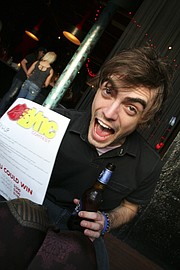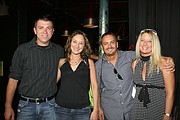Twenty years ago, they were involved with President Ronald Reagan's dedication of Edwina Sandys' "Breakthrough" sculpture on the Westminster College campus, marking the end of the Cold War and the fall of the Berlin Wall the year before.
Tuesday morning, a panel of people involved with that dedication - Bruce Hackmann, who worked in public relations for Westminster at the time; Kermit Miller of KRCG, who covered the event; then-Westminster vice president of development Jack Marshall; Westminster professor Bob Seelinger and Warren Hollrah, who worked for the Churchill Memorial at the time - gathered to reminisce about that day and the events leading up to it.
"We've had a lot of fun up here in the last 10 minutes just trying to see if any of us have a memory left," Hackmann joked to start off the discussion. "Let's set the table back to 21 years ago today ... the fall of the Berlin Wall, and see what memories we have of that event."
Hackmann said he remembers watching the wall come down on television, recalling "people climbing on the wall, hitting it with sledgehammers."
"I don't think we really understood what was happening," he said.
Miller noted watching the Berlin Wall be torn down on live television "was an event of a kind you don't see very often in life."
He asked how many people in the room were under 20 years old, before explaining that to those who were born in the middle of the Cold War, their understanding was "there was this thing called the Soviet Union ... that ruled Eastern Europe with an iron fist."
"There was the west and freedom, and there was the Soviet Union," Miller said. "To see that come apart at the seams, and not really understand why ... you just saw it fall."
Like Hackmann he described watching "people stand on the wall with sledgehammers and pound on that wall."
"On one hand, it looked like a bunch of college students having a good time over the weekend," Miller said. "On the other hand, this was stunning, it was hypnotic."
"We were mesmerized by what we were seeing, and not quite sure what it meant," agreed Seelinger.
Miller pointed out that the sculpture itself - created by the granddaughter of Winston Churchill, who made Westminster College famous when he gave his "Iron Curtain" speech here - symbolizes the contrast between the two sides of the Cold War, and, more specifically, of Germany.
"There's no graffiti on the East side," Miller observed. "You have the bright, colorful, expressive side and the repressive, gray side."
Hackmann recalled that "Edwina actually picked out the sections she liked partially because of the graffiti."
He then asked Marhsall to share how the wall pieces made their way from Germany to New York, where Sandys used them to create her sculpture, and then to Fulton.
Marshall said the sections were shipped by boat and unloaded at a concrete company in Queens, where Sandys "had to figure out how to carve the figures."
"The concrete was six or eight inches thick, and had reinforcement running throughout it," he said. "Eventually they laid it flat and used a water jet with pieces of garnet in the water and were able to saw through. There was only one problem: They also realized they were cutting through the floor of the building."
Marshall said the cutouts of the man and woman now are at the Franklin Delano Roosevelt Museum where they are the centerpiece of a sculpture called "Break Free."
"Breakthrough" then was put on display at IBM headquarters in New York City for two weeks before it was taken apart and shipped by truck to Fulton.
Miller recalled coming to Fulton to cover the installation.
"It was a construction site; there was a huge crane and men in construction hats with tool belts, and then there was this little, diminutive woman with a British accent who was in charge," Miller said. "She was very concerned things were going to go back together properly."
When Hackmann turned the subject to the actual dedication, Miller said his most clear recollection is of key speaker President Ronald Reagan.
"I have a photographer's memory of that day - I just remember that stage and images coming off that stage," the veteran newsman said. "That's probably the last time I remember President Reagan looking like the president of the United States.
"He really struck me as a man who probably didn't expect to live long enough to do what he was doing that day: Observing the dissolution of the Soviet Union. That day was as much a crowning achievement for him as anything when he was in office."
Miller also recalled Reagan as being "a man of emotion" that day.
"He departed from his script and was waxing on the possibility of a world without walls," he said. "He really believed there would be a time when we didn't have walls like that any more."
Seelinger shared a similar overriding impression of that day.
"This was Ronald Reagan sounding and appearing very presidential; there was a deep resonance in his voice and conviction in what he said," Seelinger said. "Going back and reading (the speech) last night, I was struck by how classic a Reagan speech it was. It was a combination of Ronald Reagan the president and orator, it was folksy and had anecdotes ... gave the idea you can come from anywhere and become an American."
He pointed out that Reagan also "talked about the college in a way we always wanted to be," extolling preparation of students for dealing with a diversity of cultures and working, living and being leaders in a truly global community.
"Ronald Reagan talked about how this school was poised to do those things," Seelinger said. "(That speech) represents what we've become as an institution."
Hollrah pointed out it was symbolic that Reagan was chosen to speak at the "Breakthrough" dedication, given his connection with bringing pressure upon the Soviet Union to put an end to the Iron Curtain.
"In 1988 he stood before the Brandenburg Gate, and he said "Mr. Gorbachev, if you believe in freedom, if you believe in democracy, tear down this wall,'" Hollrah quoted.
He also referenced Reagan's statement regarding eliminating walls, noting that is how he believes Sandys would like "Breakthrough" to be perceived.
"Edwina wants her sculpture to symbolize more than her grandfather's Iron Curtain speech; not just the fall of the Iron Curtain, but that walls divide mankind," Hollrah said.



